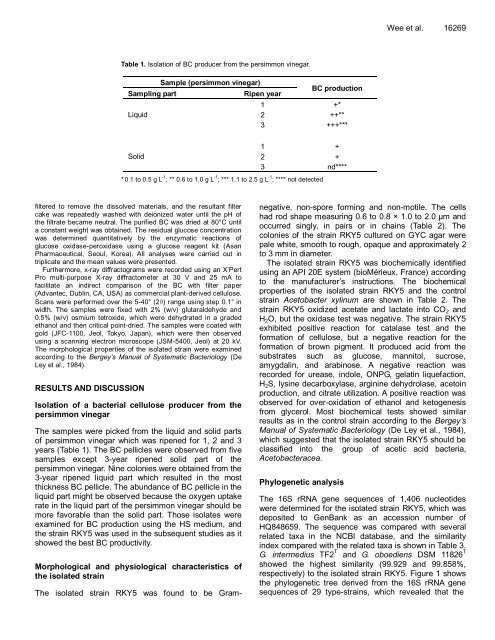(L.) C. Jeffrey from India using internal transcribed - Academic ...
(L.) C. Jeffrey from India using internal transcribed - Academic ...
(L.) C. Jeffrey from India using internal transcribed - Academic ...
Create successful ePaper yourself
Turn your PDF publications into a flip-book with our unique Google optimized e-Paper software.
Table 1. Isolation of BC producer <strong>from</strong> the persimmon vinegar.<br />
Sample (persimmon vinegar)<br />
Sampling part Ripen year<br />
Liquid<br />
Solid<br />
BC production<br />
1 +*<br />
2 ++**<br />
3 +++***<br />
1 +<br />
2 +<br />
3 nd****<br />
* 0.1 to 0.5 g L -1 ; ** 0.6 to 1.0 g L -1 ; *** 1.1 to 2.5 g L -1 ; **** not detected<br />
filtered to remove the dissolved materials, and the resultant filter<br />
cake was repeatedly washed with deionized water until the pH of<br />
the filtrate became neutral. The purified BC was dried at 80°C until<br />
a constant weight was obtained. The residual glucose concentration<br />
was determined quantitatively by the enzymatic reactions of<br />
glucose oxidase-peroxidase <strong>using</strong> a glucose reagent kit (Asan<br />
Pharmaceutical, Seoul, Korea). All analyses were carried out in<br />
triplicate and the mean values were presented.<br />
Furthermore, x-ray diffractograms were recorded <strong>using</strong> an X’Pert<br />
Pro multi-purpose X-ray diffractometer at 30 V and 25 mA to<br />
facilitate an indirect comparison of the BC with filter paper<br />
(Advantec, Dublin, CA, USA) as commercial plant-derived cellulose.<br />
Scans were performed over the 5-40° (2 ) range <strong>using</strong> step 0.1° in<br />
width. The samples were fixed with 2% (w/v) glutaraldehyde and<br />
0.5% (w/v) osmium tetroxide, which were dehydrated in a graded<br />
ethanol and then critical point-dried. The samples were coated with<br />
gold (JFC-1100, Jeol, Tokyo, Japan), which were then observed<br />
<strong>using</strong> a scanning electron microscope (JSM-5400, Jeol) at 20 kV.<br />
The morphological properties of the isolated strain were examined<br />
according to the Bergey’s Manual of Systematic Bacteriology (De<br />
Ley et al., 1984).<br />
RESULTS AND DISCUSSION<br />
Isolation of a bacterial cellulose producer <strong>from</strong> the<br />
persimmon vinegar<br />
The samples were picked <strong>from</strong> the liquid and solid parts<br />
of persimmon vinegar which was ripened for 1, 2 and 3<br />
years (Table 1). The BC pellicles were observed <strong>from</strong> five<br />
samples except 3-year ripened solid part of the<br />
persimmon vinegar. Nine colonies were obtained <strong>from</strong> the<br />
3-year ripened liquid part which resulted in the most<br />
thickness BC pellicle. The abundance of BC pellicle in the<br />
liquid part might be observed because the oxygen uptake<br />
rate in the liquid part of the persimmon vinegar should be<br />
more favorable than the solid part. Those isolates were<br />
examined for BC production <strong>using</strong> the HS medium, and<br />
the strain RKY5 was used in the subsequent studies as it<br />
showed the best BC productivity.<br />
Morphological and physiological characteristics of<br />
the isolated strain<br />
The isolated strain RKY5 was found to be Gram-<br />
Wee et al. 16269<br />
negative, non-spore forming and non-motile. The cells<br />
had rod shape measuring 0.6 to 0.8 × 1.0 to 2.0 µm and<br />
occurred singly, in pairs or in chains (Table 2). The<br />
colonies of the strain RKY5 cultured on GYC agar were<br />
pale white, smooth to rough, opaque and approximately 2<br />
to 3 mm in diameter.<br />
The isolated strain RKY5 was biochemically identified<br />
<strong>using</strong> an API 20E system (bioMérieux, France) according<br />
to the manufacturer’s instructions. The biochemical<br />
properties of the isolated strain RKY5 and the control<br />
strain Acetobacter xylinum are shown in Table 2. The<br />
strain RKY5 oxidized acetate and lactate into CO2 and<br />
H2O, but the oxidase test was negative. The strain RKY5<br />
exhibited positive reaction for catalase test and the<br />
formation of cellulose, but a negative reaction for the<br />
formation of brown pigment. It produced acid <strong>from</strong> the<br />
substrates such as glucose, mannitol, sucrose,<br />
amygdalin, and arabinose. A negative reaction was<br />
recorded for urease, indole, ONPG, gelatin liquefaction,<br />
H2S, lysine decarboxylase, arginine dehydrolase, acetoin<br />
production, and citrate utilization. A positive reaction was<br />
observed for over-oxidation of ethanol and ketogenesis<br />
<strong>from</strong> glycerol. Most biochemical tests showed similar<br />
results as in the control strain according to the Bergey’s<br />
Manual of Systematic Bacteriology (De Ley et al., 1984),<br />
which suggested that the isolated strain RKY5 should be<br />
classified into the group of acetic acid bacteria,<br />
Acetobacteracea.<br />
Phylogenetic analysis<br />
The 16S rRNA gene sequences of 1,406 nucleotides<br />
were determined for the isolated strain RKY5, which was<br />
deposited to GenBank as an accession number of<br />
HQ848659. The sequence was compared with several<br />
related taxa in the NCBI database, and the similarity<br />
index compared with the related taxa is shown in Table 3.<br />
G. intermedius TF2 T and G. oboediens DSM 11826 T<br />
showed the highest similarity (99.929 and 99.858%,<br />
respectively) to the isolated strain RKY5. Figure 1 shows<br />
the phylogenetic tree derived <strong>from</strong> the 16S rRNA gene<br />
sequences of 29 type-strains, which revealed that the

















